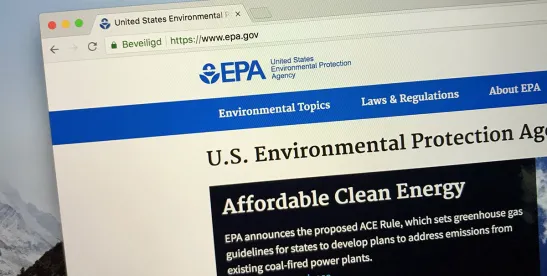On May 2, 2025, the White House issued its so-called “skinny budget” (essentially a summary version of the complete budget proposal, which will follow later) for fiscal year 2026. EPA funding was referenced in some detail in the skinny budget, with notable reductions in Superfund, clean water, and scientific research areas.
The biggest area of the EPA budget that is proposed for cuts deals with funding the federal government has traditionally provided to states to support water infrastructure projects designed to improve aging water systems and deliver clean water to citizens. The budget proposes to cut $2.46 billion from the State Revolving Fund (SRF), explaining that the states individually should have responsibility for funding their own water infrastructure projects. In a related line item for cuts are $1 billion in the EPA’s Categorical grant program, which has traditionally also been used by states for a myriad of environmental and infrastructure-related projects.
EPA funding for the Superfund program is also set to be slashed by $254 million. This is not a surprise, though, as we have written for months that the Superfund program is likely to see considerable funding cuts under the Trump administration.
Finally, the EPA’s research arm will see cuts of $235 million to its budget. $281 million in funding to the research department will remain intact “for statutorily required research in support of core mission areas.”
PFAS Action List
While none of the planned reductions are overly surprising, confirmation of the cuts does lend support to our views last week related to the EPA’s Action List that, despite language in the Action List suggesting continued efforts to address PFAS (particularly in water and with respect to Superfund), reductions in funding make those propositions tenuous.
May and June 2025 will provide key insights into EPA’s intentions with respect to PFAS, as it is due to report to the court as to how it plans to address the Safe Drinking Water Act and CERCLA regulations enacted by the prior EPA. Until then, the most conservative approach with respect to the current EPA’s intentions with respect to PFAS should continue to be a “wait and see” approach until actual actions are taken. Companies should not, however, be lulled into a sense of false security thinking that the EPA’s slow approach to PFAS means a presidential term free from PFAS risk. To the contrary, while the federal government will act much slower than than under the prior EPA, states will once again step in to fill the regulatory void with respect to FPAS and the ever-increasing PFAS litigation impacting companies that were not PFAS manufacturers will continue to present significant risks to companies.




 />i
/>i

